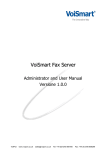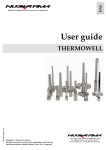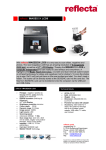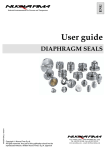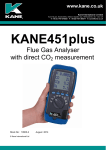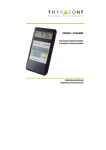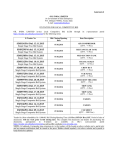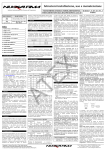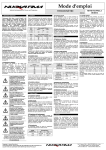Transcript
User guide Industrial instrumentation for Pressure and Temperature DIFFERENTIAL PRESSURE GAUGE MD 1. General information The instrument works in safe conditions when correctly selected and installed in the system and when the rules concerning the product as well as the maintenance procedures established by the manufacturer are respected. The staff charged with the selection, installation and maintenance of the instrument must be able to recognize the conditions that may negatively affect the instrument's ability to work and which may lead to premature breakage. The staff must therefore be technically qualified and properly trained, and must carry out the procedures called for in the plant regulations. Standards Directive P.E.D. 97/23/CE Nuova Fima instruments are designed and manufactured according to the safety rules included in the safety international prevailing standards. According to the 97/23/CE standard the NUOVA FIMA pressure gauges are classified in 2 categories PS 200 bar these instruments should not satisfy the essential safety standards but they have only to be designed and manufactured according to a SEP-Sound Engineering Practice and they do not have to bring any CE marking. PS >200 bar these instruments should satisfy the essential safety standards established by the PED, they are classified as category I and they are certified according to Form A. They should bring the CE marking as reproduced below. 1.1 Intended use These instruments are used to check differential pressures of gaseous liquids wich do not have high viscosity and do not crystalizee. In presence of high temperature, high viscosity and corrosive process fluid or which can crystalize these instruments can be fitted with remote mounting diaphragm seals. Before installation be sure that the right instrument has been selected following the working conditions and in particular the range, the working temperature and the compatibility between the material used and the process medium. 2. Installation and commissionig Before installation and commissioning verify the connection distance of the instrument process connection and the possible valve where it will be installed. INSTRUMENT MD 13 MD 14 MD 15 MD 16 MD 17 MD 18 CONNECTION DISTANCE 50mm 50mm 50mm 50mm 54mm 23mm Tighten the instrument thread forcing on the process connection area by a special wrench without forcing with the hands. As for cylindric threading process connections (GASmetric), a head gasket compatible with the gas or fluid medium should be used. If the connection thread is conic simply screw on the connection. In order to imrpove the thread tightness it is recommended to wrap the male thread with PTFE tape. Not suitable for cylindric threading. In both cases twist through two exagon wrenches the first applied on the plane faces of the connection and the other the pressure connection. We recommend to fix the instrument through a pipe or panel mounting bracket. After mounting the instrument dial should be in vertical position except otherwise indicated on the instrument. In order to remove the instrument for maintenance much easier it is recommended to apply an shut-off valve between the instrument and the system. 2.1 Installation Installation should be always carried out carefully in order to prevent any pressure spike or sudden temperature fluctuations. Therefore the shut-off valves should be opened slowly in order to check if there are restrictions, sediments or condensate which could affect the real values. The product warranty is no longer valid in case of non-authorized modifications and of wrong use of the product. The manufacturer disclaims all responsibility in case of damages caused by the improper use of the product and by the non-respect of the instructions reported in this manual. STATIC ONE-SIDE 100÷1600mbar 25÷200bar 250 bar 0,72÷40 bar 4.4 Dangerous process fluids In models 13 and 14 verify that fluids affecting the positive and the negative sides do not cause dangerous chemical reactions if a contact is established. If this occurs we recommend to use models 15, 16 or 17. When the instrument does not work correctly the sensing element can break or crack; if the medium measured is inflammable and the measurement activity is continuous an explosive atmosphere could generate inside and outside the instrument case. In this case it is fundamental an appropriate maintenance program through which the damaged instruments are replaced before the leakage occurs. For missing data on one-side pressure infunction of the instrument range, please see the data sheet on our web side www.nuovafima.com Static pressure both-side INSTRUMENT MD 13 MD 14 MD 15 MD 16 MD 17 MD 18 STATIC BOTH-SIDE 100bar max 25bar 200 bar 100 bar 400 bar max 40 bar 4.5 Mechanical stress If the installation points are subjected to stress the instruments should be remote mounted and connected through hoses. Instruments should be chosen among those suitable for surface or panel mounting. 3.4 Overpressure The instrument is protected against overpressure only in case of short period overpressure disturbances. In case of longer unilateral overpressure the O-ring can adhere so strongly to the clamps that they do not detach regularly not even when the differential pressure decreases. 3.5 Vibrations When the instrument support is subjected to vibrations we can consider different solutions such as: a) the use of liquid filled instruments; b) remote mounted instruments connected through hoses (suitable for strong or irregular vibrations). Vibrations can be noticed if the index keeps on oscillating. 3.6 Dampening liquid filling The dampening liquid is generally used to reduce vibrations of the moving parts due to vibrations and/or pulsations. The dampening liquid must be chosen very carefully in case the instrument operates with oxidant media such as oxygen, chlorine, nitric acid, hydrogen peroxide, etc. In presence of oxidant agents there is a potential risk of chemical reaction, inflammability and explosion of the instrument. In this case proper filling liquids must be used. The type of the filling liquid as well as its ambient temperature use limits should be taken into consideration. Dampening liquids Working temperature Glycerinea 98% Silicon oil +15…+65°C (+60…+150°F) -45…+65°C (-50…+150°F) The user is totally responsible for the instrument installation and maintenance. Disconnect the instruments only after depressurization of the system.. Please follow these instructions: 1. open the by-pass valve “1”; 2. open the root valve “3”; 3. open the shut-off valve “2” of the plus side (+); 4. verify that the chambers are completely filled up through the blow out vents placed on the top of the instrument. 5. close the by-pass valve “1”; open the shut-off valve “2” of the minus side (-). 3. Operation limits 3.1 Process and ambient temperature This instrument is designed to be used in safety conditions that is in an ambient temperature between –40 and+65°C. As for the filled model please see the paragraph “DAMPENING LIQUID FILLING” cleaned and degreased with special products and packed in polyethylene bags. The user must take the necessary precautions to ensure that the connection and the elastic element are kept clean after the pressure gauge has been unpacked. 4.3 Breakage for vibrations Vibrations most commonly cause an abnormal deterioration of the parts in mouvement bringing to a gradual loss of accuracy and then to a total block of the pointer. 4. Wrong uses Follow carefully the specific safety rules in case of measuring oxygen pressure, acetylene, inflammable or toxic gas or liquids. In order to verify the working and manufacturing features of the instruments read the catalogue sheets in the most up-dated edition available on.line on www.nuovafima.com STRUMENTO MD 13 MD 14 MD 15 MD 16 MD 17 MD 18 3.3 Dynamic and cyclic pressures Not accepted. This manual does not concern the instruments conforming to standardl 94/9/CE (ATEX) The process fluids residuals in the disassembled gauges could affect people, the environment and the system. It is highly recommended to take proper precautions. 3.2 Working pressure This instrument is designed to work with a differential pressure of 100% of the full scale range. Static pressure one-side MI-MD-ENG_2 04/2012 4.1 Breakage for corrosion It occurs when the sensing element material is subjected to chemical attack by the substances contained in the medium to be measured or in the ambient surrounding the pressure system. The damage consists in a punctiform leakage or in a stress crack due to the material weakening. The sensing element is normally characterised by a reduced thickness, so it works in condition of strong mechanical stress. Tehrefore the chemical compatibility with the fluid to be measured has to be taken into consideration. No common material can be saved from a chemical attack which can be characterised by different factors:concentration, temperature and mixture of the different chemical substances. 6. Maintenance The instrument’s characteristics should be maintained during time through a special maintenance program on which skilled personnel should work on. The instrument features must be maintained in order to prevent damages due to high temperatures, risk of fire and explosion due to abnormal instrument working. As for heavy work instruments operating in severe conditions plants (vibrations, pulsating pressures, corrosive or sedimentous fluids, combustible or inflammable media) we recommend to schedule their replacement according to the maintenance program schedule. It is recommended to verify the sensing element condition, the indication pressure, the sensing element corrosion level (as far as the diaphragm seals are concerned), the gaskets tightness, and the condensate presence inside the housing. In case the instrument does not work properly it is necessary to proceed to an unschedule examination procedure. 6.1 Routine check In order to verify the sensing element condition install the instrument on the pressure generator introducing an interception valve between them. Apply the maximum pressure value to the gauge and exclude it form the pressure source through the valve. Any possible leakage of the sensing element can be noticed from the slow return of the pointer to zero. In order to verify the accuracy of indication create in laboratory a stable pressure value and apply it to the instrument to be examined and to a pressure test/primary testing instrument. 6.2 Recalibration If after recalibration results are different from the nominal values declared on the catalogue sheet the recalibration procedure should be repeated. It is recommended to return the instrument to NUOVA FIMA for this procedure. NUOVA FIMA will not be responsible for any non authorized intervention on the instrument. Moreover the contract warranty and the CE Conformity Declaration will be no longer valid. 7. Disposal It is recommended to remove the window and blow out vent before disposal as aluminium and stainless steel. The fluid remaining inside the instrument can be dangerous or toxic. 4.2 Breakage for explosion It occurs after a violent release of thermal energy due to some chemical reactions such as the adiabatic compression of oxygen in presence of hydrocarbons/combustibles. It is commonnly accepted that it is impossible to prevent the effects of this kind of damage. Pressure gauges suitable for use with oxygen are marked: “Oxygen - No lubrification” and/or they are marked with a crossed out oil can symbol on the dial Also the models with double diaphragm seal are filled up between the two diaphragms with a special neutral fluorolube liquid. Instruments are supplied properly Copyright Nuova Fima S.p.A. All rights reserved. Any part of this publication should not be reproduced without a written Nuova Fima’s S.p.A. approval Via C. Battisti, 59/61 – 28045 INVORIO (No) – Italy Tel. +39 0322 253200 – Fax +39 0322 253232 www.nuovafima.com – e-mail: [email protected]



